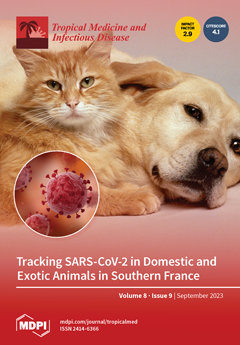Up-to-date knowledge of key epidemiological aspects of each
Plasmodium species is necessary for making informed decisions on targeted interventions and control strategies to eliminate each of them. This study aims to describe the epidemiology of plasmodial species in Mali, where malaria is hyperendemic and seasonal. Data reports collected during high-transmission season over six consecutive years were analyzed to summarize malaria epidemiology. Malaria species and density were from blood smear microscopy. Data from 6870 symptomatic and 1740 asymptomatic participants were analyzed. The median age of participants was 12 years, and the sex ratio (male/female) was 0.81. Malaria prevalence from all
Plasmodium species was 65.20% (95% CI: 60.10–69.89%) and 22.41% (CI: 16.60–28.79%) for passive and active screening, respectively.
P. falciparum was the most prevalent species encountered in active and passive screening (59.33%, 19.31%). This prevalence was followed by
P. malariae (1.50%, 1.15%) and
P. ovale (0.32%, 0.06%). Regarding frequency,
P. falciparum was more frequent in symptomatic individuals (96.77% vs. 93.24%,
p = 0.014). In contrast,
P. malariae was more frequent in asymptomatic individuals (5.64% vs. 2.45%,
p < 0.001).
P. ovale remained the least frequent species (less than 1%), and no
P. vivax was detected. The most frequent coinfections were
P. falciparum and
P. malariae (0.56%). Children aged 5–9 presented the highest frequency of
P. falciparum infections (41.91%). Non-
falciparum species were primarily detected in adolescents (10–14 years) with frequencies above 50%. Only
P. falciparum infections had parasitemias greater than 100,000 parasites per µL of blood.
P. falciparum gametocytes were found with variable prevalence across age groups. Our data highlight that
P. falciparum represented the first burden, but other non-
falciparum species were also important. Increasing attention to
P. malariae and
P. ovale is essential if malaria elimination is to be achieved.
Full article






